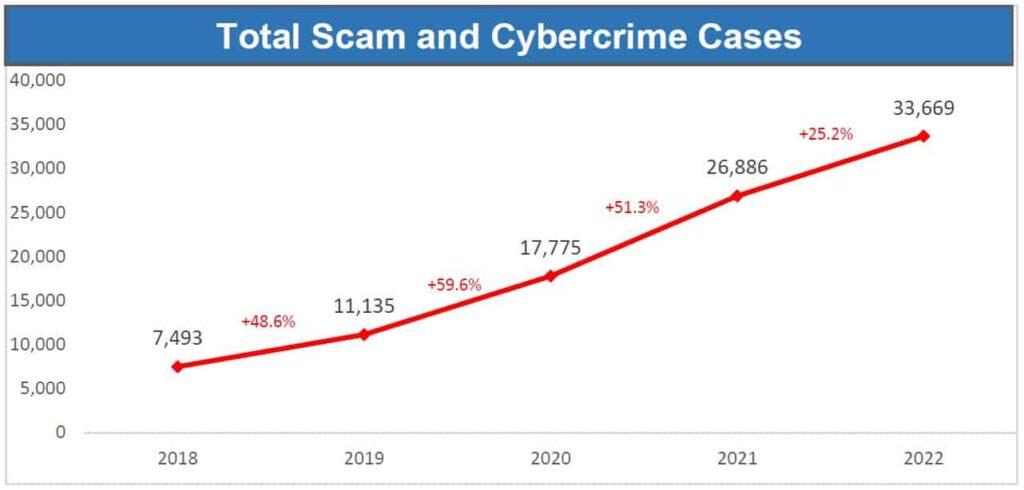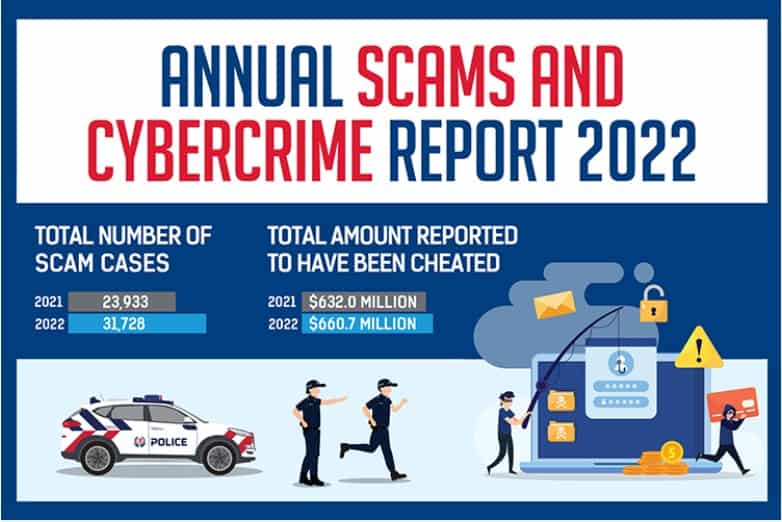Digital evidence plays an increasingly important role in investigations. Videos, still images, audio recordings, digital tags of physical evidence, social media content, and other forms of digital evidence have changed how investigators approach building strong cases and solving crimes. However, the rapid proliferation of digital data and evolving technologies have presented significant challenges for law enforcement.
State of Cybercrime in Singapore
In Singapore where cybercrimes and online scams account for the majority of crimes reported in 2022, digital evidence has become a critical component in criminal forensic investigations.
Figure 1: Rising scams and cybercrime

Figure 2: Scams cases 2022 vs 2021

The number of scams and cybercrime cases increased by 25.2%, growing from 26,886 cases in 2021 to 33,669 in 2022. This amounts to $660.7 million of losses in 2022 – a 4.5% growth from $632.0 million in 2021.
The rise in cybercrimes and online scams everywhere underscores the urgent need for robust digital evidence collection, storage, management, and analysis capabilities. Law enforcement agencies are increasingly investing in advanced technologies and skilled personnel to effectively gather and examine digital evidence, enhancing their ability to combat modern-day crimes.
But of course, digital evidence helps prevent more than just cybercrimes. Security cameras can help deter crimes, and when crimes are recorded those video recordings provide vital evidence.
The challenge for enforcers
A key challenge faced by investigators is the sheer volume of digital data generated each day. The advent of CCTV cameras, smartphones, social media platforms, and Internet of Things (IoT) devices has resulted in an explosion of potential evidence.
Sorting through this massive trove of information requires sophisticated tools and techniques to identify relevant data and extract meaningful insights.
Addressing the challenge
To address this challenge, law enforcement agencies are leveraging cutting-edge forensic software and hardware solutions. These tools enable investigators to extract data from various devices such as smartphones, computers, and cloud storage, in a forensically sound manner.
Advanced data recovery techniques help retrieve deleted files, and specialised software can analyse metadata such as timestamps and geolocation data, to establish the authenticity and integrity of digital evidence.
However, the dynamic nature of technology poses an ongoing challenge.
To address these challenges, law enforcement agencies collaborate closely with academic institutions, private sector entities, international organisations, and technology experts. This collaboration facilitates knowledge sharing, joint research projects, and the development of innovative solutions.
By fostering a multidisciplinary approach, law enforcement can leverage the expertise of digital forensics specialists, cybersecurity analysts, and legal professionals to ensure comprehensive and effective investigations.
Another critical aspect of digital evidence management is ensuring its admissibility in court. To establish the evidentiary value of digital evidence, investigators must adhere to strict procedures to maintain the chain of custody and demonstrate integrity.
This involves documenting every step of the collection, preservation, and analysis process, ensuring that the evidence remains untampered with and authentic – which is why many agencies increasingly rely on a digital evidence management system that automatically creates an audit trail of every action.
Additionally, experts in digital forensics may be required to testify in court, explaining the technical aspects of the evidence and its relevance to the case.
As technology continues to evolve, law enforcement agencies must remain proactive in their approach to digital evidence. Training programs and continuous professional development are essential to equip investigators with the necessary skills to navigate the complexities of digital forensics.
Moreover, regular updates to legislation and legal frameworks are imperative to address emerging challenges and ensure the admissibility of digital evidence in court.
Cannot be overstated
The importance of digital evidence in investigations cannot be overstated. To harness the potential of digital evidence, law enforcement agencies must continue to invest in their respective digital transformation efforts, collaborate with relevant stakeholders, and upgrade their digital skills.
By doing so, they can adapt to the ever-changing digital landscape and ensure justice is served faster and more efficiently in today’s digital age.



